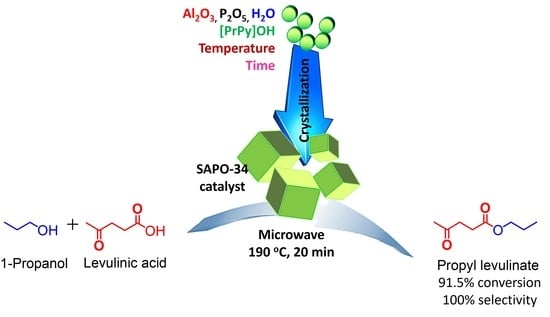Effects of Synthesis Variables on SAPO-34 Crystallization Templated Using Pyridinium Supramolecule and Its Catalytic Activity in Microwave Esterification Synthesis of Propyl Levulinate
Abstract
1. Introduction
2. Results and Discussion
2.1. Single-Parameter Tuning Synthesis of SAPO-34
2.1.1. Time-Dependent Formation Study of SAPO-34
2.1.2. Effect of P/Al Molar Ratio
2.1.3. Effect of Si Content
2.1.4. Effect of [PrPy]OH Content
2.1.5. Effect of H2O Content
2.1.6. Effect of Crystallization Temperature
2.2. Surface Characterizations of SAPO-34
2.3. Catalytic Reaction Study
3. Materials and Methods
3.1. Preparation of 1-Propylpyridinium Hydroxide, [PrPy]OH
3.2. Single-Parameter Tuning Synthesis and Crystallization of SAPO-34 Microporous Solid
3.3. Characterization
3.4. Catalytic Reaction Study
4. Conclusions
Supplementary Materials
Author Contributions
Funding
Acknowledgments
Conflicts of Interest
References
- Ng, E.-P.; Awala, H.; Komaty, S.; Mintova, S. Microwave-green synthesis of AlPO-n and SAPO-n (n = 5 and 18) nanosized crystals and their assembly in layers. Microporous Mesoporous Mater. 2019, 280, 256–263. [Google Scholar] [CrossRef]
- Tosheva, L.; Ng, E.-P.; Mintova, S.; Hölzl, M.; Metzger, T.H.; Doyle, A.M. AlPO4-18 Seed Layers and Films by Secondary Growth. Chem. Mater. 2008, 20, 5721–5726. [Google Scholar] [CrossRef]
- Ng, E.-P.; Delmotte, L.; Mintova, S. Selective capture of water using microporous adsorbents to increase the lifetime of lubricants. ChemSusChem 2009, 2, 255–260. [Google Scholar] [CrossRef] [PubMed]
- Usman, M. Recent Progress of SAPO-34 Zeolite Membranes for CO2 Separation: A Review. Membranes 2022, 12, 507. [Google Scholar] [CrossRef]
- Park, J.W.; Lee, J.Y.; Kim, K.S.; Hong, S.B.; Seo, G. Effects of cage shape and size of 8-membered ring molecular sieves on their deactivation in methanol-to-olefin (MTO) reactions. Appl. Catal. A Gen. 2008, 339, 36–44. [Google Scholar] [CrossRef]
- Zhao, L.; Yang, G.; Hu, H.; Sun, Y.; Ma, Z.; Peng, P.; Ng, E.-P.; Tian, P.; Guo, H.; Mintova, S. SAPO-34 crystals with nanosheet morphology synthesized by pyrophosphoric acid as new phosphorus source. Microporous Mesoporous Mater. 2022, 333, 111753. [Google Scholar] [CrossRef]
- Nishitoba, T.; Nozaki, T.; Park, S.; Wang, Y.; Kondo, J.N.; Gies, H.; Yokoi, T. CHA-type zeolite prepared by interzeolite conversion method using FAU and LTL-type zeolite: Effect of the raw materials on the crystallization mechanism, and physico-chemical and catalytic properties. Catalysts 2020, 10, 1204. [Google Scholar] [CrossRef]
- Li, J.; Li, Z.; Han, D.; Wu, J. Facile synthesis of SAPO-34 with small crystal size for conversion of methanol to olefins. Powder Technol. 2014, 262, 177–182. [Google Scholar] [CrossRef]
- Liu, G.; Tian, P.; Liu, Z. Chin. Synthesis of SAPO-34 molecular sieves templated with diethylamine and their properties compared with other templates. J. Catal. 2012, 33, 174–182. [Google Scholar]
- Zhou, H.; Wang, Y.; Wei, F.; Wang, D.; Wang, Z. Kinetics of the reactions of the light alkenes over SAPO-34. Appl. Catal. A Gen. 2008, 348, 135–141. [Google Scholar] [CrossRef]
- Askari, S.; Halladj, R.; Sohrabi, M. Methanol conversion to light olefins over sonochemically prepared SAPO-34 nanocatalyst. Microporous Mesoporous Mater. 2012, 163, 334–342. [Google Scholar] [CrossRef]
- Dumitriu, E.; Azzouz, A.; Hulea, V.; Lutic, D.; Kessler, H. Synthesis, characterization and catalytic activity of SAPO-34 obtained with piperidine as templating agent. Microporous Mesoporous Mater. 1997, 10, 1–12. [Google Scholar] [CrossRef]
- Prakash, A.M.; Unnikrishnan, S. Synthesis of SAPO-34: High silicon incorporation in the presence of morpholine as template. J. Chem. Soc. Faraday Trans. 1994, 90, 2291–2296. [Google Scholar] [CrossRef]
- Ng, E.-P.; Itani, L.; Sekhon, S.S.; Mintova, S. Micro- to macroscopic observations of MnAlPO-5 nanocrystal growth in ionic-liquid media. Chem. Eur. J. 2010, 16, 12890–12897. [Google Scholar] [CrossRef]
- Khoo, D.Y.; Kok, W.-M.; Mukti, R.R.; Mintova, S.; Ng, E.-P. Ionothermal approach for synthesizing AlPO-5 with hexagonal thin-plate morphology influenced by various parameters at ambient pressure. Solid State Sci. 2013, 25, 63–69. [Google Scholar] [CrossRef]
- Smith, J.G. Organic Chemistry, 6th ed.; McGraw-Hill Education: New York, NY, USA, 2017. [Google Scholar]
- Majano, G.; Ng, E.-P.; Lakiss, L.; Mintova, S. Nanosized molecular sieves utilized as an environmentally friendly alternative to antioxidants for lubricant oils. Green Chem. 2011, 13, 2435–2440. [Google Scholar] [CrossRef]
- Wong, J.-T.; Ng, E.-P.; Adam, F. Microscopic Investigation of Nanocrystalline Zeolite L Synthesized from Rice Husk Ash. J. Am. Ceram. Soc. 2011, 95, 805–808. [Google Scholar] [CrossRef]
- Cundy, C.S.; Cox, P.A. The hydrothermal synthesis of zeolites: Precursors, intermediates and reaction mechanism. Microporous Mesoporous Mater. 2005, 82, 1–78. [Google Scholar] [CrossRef]
- Auwal, I.; Khoerunnisa, F.; Dubray, F.; Mintova, S.; Ling, T.; Wong, K.-L.; Ng, E.-P. Effects of Synthesis Parameters on the Crystallization Profile and Morphological Properties of SAPO-5 Templated by 1-Benzyl-2,3-Dimethylimidazolium Hydroxide. Crystals 2021, 11, 279. [Google Scholar] [CrossRef]
- Van Heyden, H.; Mintova, S.; Bein, T. Nanosized SAPO-34 Synthesized from Colloidal Solutions. Chem. Mater. 2008, 20, 2956–2963. [Google Scholar] [CrossRef]
- Zhao, C.; Yang, Y.; Chen, W.; Wang, H.; Zhao, D.; Webley, P.A. Hydrothermal synthesis of novel AlPO4-5 brooms and nano-fibers and their templated carbon structures. CrystEngComm 2009, 11, 739–742. [Google Scholar] [CrossRef]
- IZA-SC Database of Zeolite Structures. Available online: https://www.izastructure.org/databases/ (accessed on 5 July 2022).
- Barthomeuf, D. Topological model for the compared acidity of SAPOs and SiAl zeolites. Zeolites 1994, 14, 394–401. [Google Scholar] [CrossRef]
- Salmasi, M.; Fatemi, S.; Hashemi, S. MTO reaction over SAPO-34 catalysts synthesized by combination of TEAOH and morpholine templates and different silica sources. Sci. Iran. 2012, 19, 1632–1637. [Google Scholar] [CrossRef]
- Baerlocher, C.; Meier, W.M.; Olson, D.H. Atlas of Zeolite Structure Types, 5th ed.; Elsevier: Amsterdam, The Netherlands, 1996. [Google Scholar]
- Concepción, P.; Nieto, J.M.L.; Mifsud, A.; Perez-Pariente, J. Preparation and characterization of Mg-containing AFI and chabazite-type materials. Zeolites 1996, 16, 56–64. [Google Scholar] [CrossRef]
- The Molecular Dimension of 1-Propylpyridinium Cation Was Estimated Using Hyperchem™-Release 7.03 for Windows Molecular Modeling System; Hypercube, Inc.: Lancaster, TX, USA, 2002.
- Newalkar, B.L.; Kamath, B.V.; Jasra, R.V.; Bhat, S.G.T. The effect of gel pH on the crystallization of aluminophosphate molecular sieve AIPO4-5. Zeolites 1997, 18, 286–290. [Google Scholar] [CrossRef]
- Ghrear, T.M.A.; Rigolet, S.; Daou, T.J.; Mintova, S.; Ling, T.C.; Tan, S.H.; Ng, E.-P. Synthesis of Cs-ABW nanozeolite in organotemplate-free system. Microporous Mesoporous Mater. 2019, 277, 78–83. [Google Scholar] [CrossRef]
- Cheong, Y.-W.; Rigolet, S.; Daou, T.J.; Wong, K.-L.; Ling, T.C.; Ng, E.-P. Crystal growth study of nanosized K-MER zeolite from bamboo leaves ash and its catalytic behaviour in Knoevenagel condensation of benzaldehyde with ethyl cyanoacetate. Mater. Chem. Phys. 2020, 251, 123100. [Google Scholar] [CrossRef]
- Jhung, S.H.; Chang, J.-S.; Hwang, J.S.; Park, S.-E. Selective formation of SAPO-5 and SAPO-34 molecular sieves with micro-wave irradiation and hydrothermal heating. Microporous Mesoporous Mater. 2003, 64, 33–39. [Google Scholar] [CrossRef]
- Newsam, J.M. The Zeolite Cage Structure. Science 1986, 231, 1093–1099. [Google Scholar] [CrossRef]
- Cundy, C.S.; Cox, P.A. The Hydrothermal Synthesis of Zeolites: History and Development from the Earliest Days to the Present Time. Chem. Rev. 2003, 103, 663–702. [Google Scholar] [CrossRef]
- Francis, R.J.; O’Hare, D. The kinetics and mechanisms of the crystallisation of microporous materials. J. Chem. Soc. Dalton Trans. 1998, 3133–3148. [Google Scholar] [CrossRef]
- Wong, S.-F.; Deekomwong, K.; Wittayakun, J.; Ling, T.C.; Muraza, O.; Adam, F.; Ng, E.-P. Crystal growth study of K-F nanozeolite and its catalytic behavior in Aldol condensation of benzaldehyde and heptanal enhanced by microwave heating. Mater. Chem. Phys. 2017, 196, 295–301. [Google Scholar] [CrossRef]
- Askari, S.; Halladj, R.; Sohrabi, M. An overview of the effects of crystallization time, template and silicon sources on hydro-thermal synthesis of sapo-34 molecular sieve with small crystals. Rev. Adv. Mater. Sci. 2012, 32, 83–93. [Google Scholar]
- Kruk, M.; Jaroniec, M.; Sayari, A. Adsorption Study of Surface and Structural Properties of MCM-41 Materials of Different Pore Sizes. J. Phys. Chem. B 1997, 101, 583–589. [Google Scholar] [CrossRef]
- Derewinski, M.; Briend, M.; Peltre, M.J.; Main, P.P.; Barthomeuf, D. Changes in the environment of si and ai in SAPO-37 zeolite during acidity measurements. J. Phys. Chem. 1993, 97, 13730–13735. [Google Scholar] [CrossRef]
- Silbey, R.J.; Alberty, R.A.; Papadantonakis, G.A.; Bawendi, M.G. Physical Chemistry, 5th ed.; John, Wiley & Sons, Inc.: Hoboken, NJ, USA, 2022. [Google Scholar]
- Beh, J.J.; Lim, J.K.; Ng, E.P.; Ooi, B.S. Synthesis and size control of zeolitic imidazolate framework-8 (ZIF-8): From the perspective of reaction kinetics and thermodynamics of nucleation. Mater. Chem. Phys. 2018, 216, 393–401. [Google Scholar] [CrossRef]
- Li, T.; Chung, S.-H.; Nastase, S.; Galilea, A.; Wang, Y.; Mukhambetov, I.; Zaarour, M.; de Miguel, J.C.N.; Cazemier, J.; Dokania, A.; et al. Influence of active-site proximity in zeolites on Brønsted acid-catalyzed reactions at the microscopic and mesoscopic levels. J. Chem. Catal. 2023, 3, 100540. [Google Scholar] [CrossRef]
- Mandari, V.; Devarai, S.K. Biodiesel production using homogeneous, heterogeneous, and enzyme catalysts via transesterification and esterification reactions: A critical review. BioEnergy Res. 2022, 15, 935–961. [Google Scholar] [CrossRef]
- Shokouhimehr, M. Magnetically separable and sustainable nanostructured catalysts for heterogeneous reduction of nitroaromatics. Catalysts 2015, 5, 534–560. [Google Scholar] [CrossRef]
- Appaturi, J.N.; Andas, J.; Ma, Y.-K.; Phoon, B.L.; Batagarawa, S.M.; Khoerunnisa, F.; Hussin, M.H.; Ng, E.-P. Recent advances in heterogeneous catalysts for the synthesis of alkyl levulinate biofuel additives from renewable levulinic acid: A comprehensive review. Fuel 2022, 323, 124362. [Google Scholar] [CrossRef]
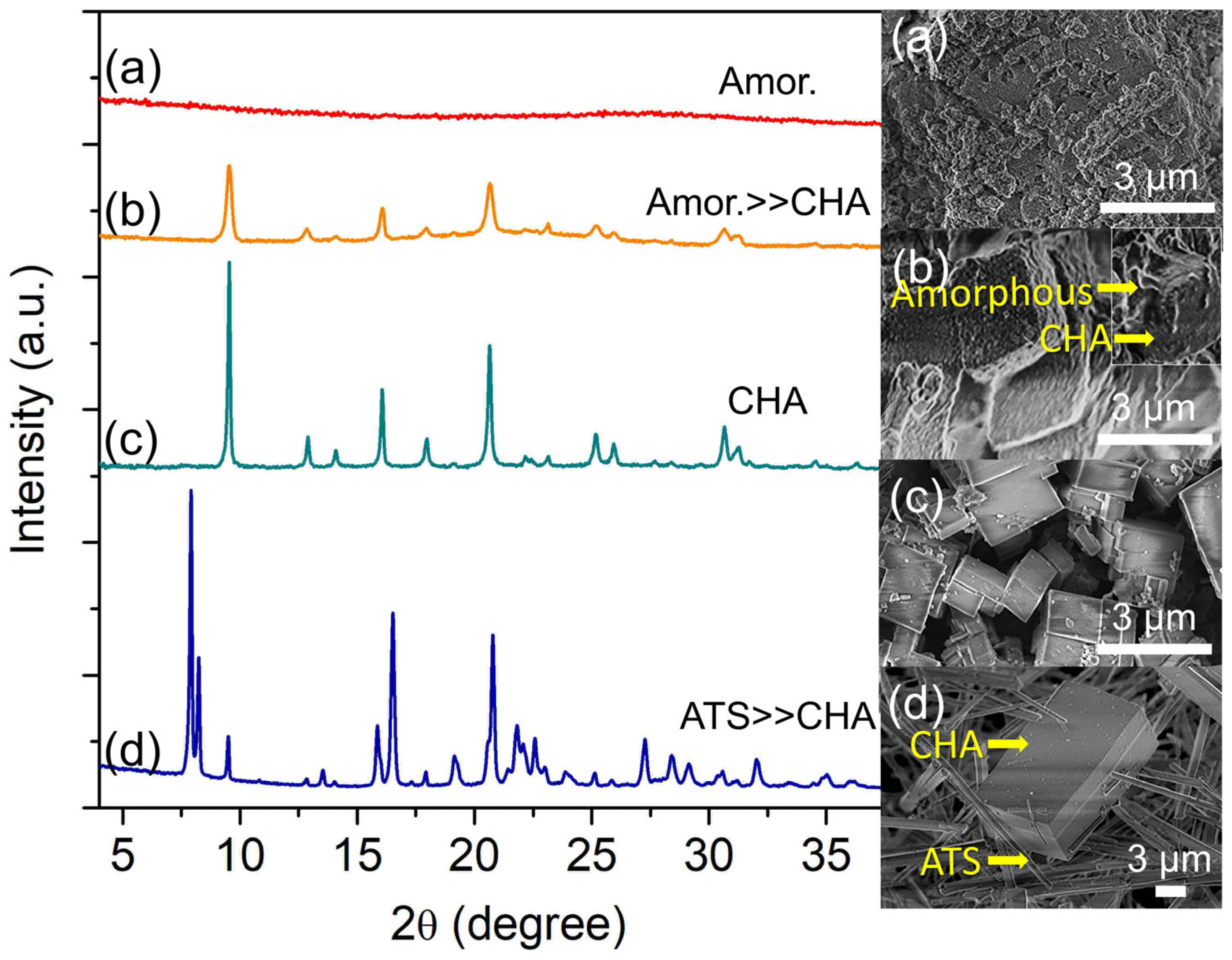
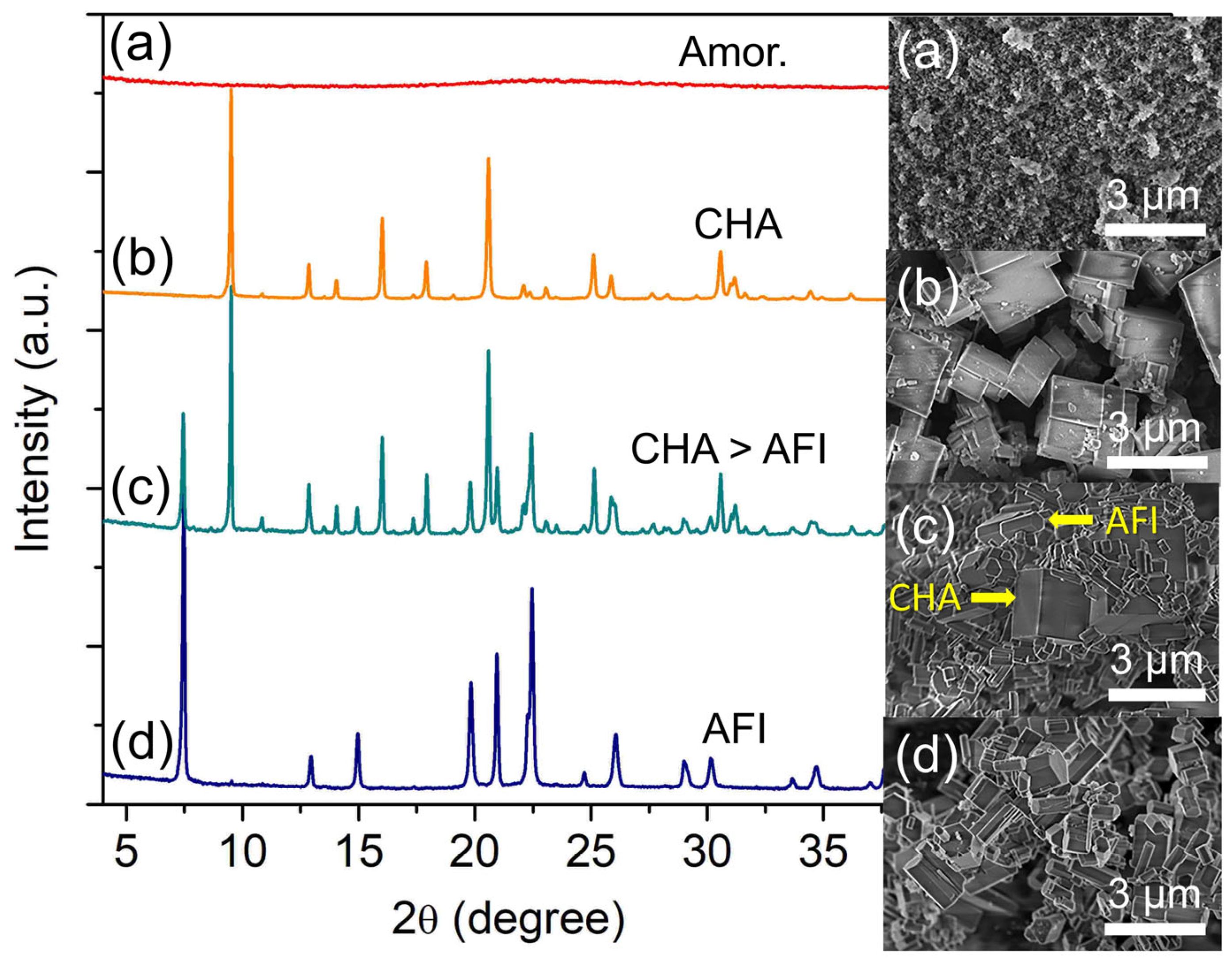
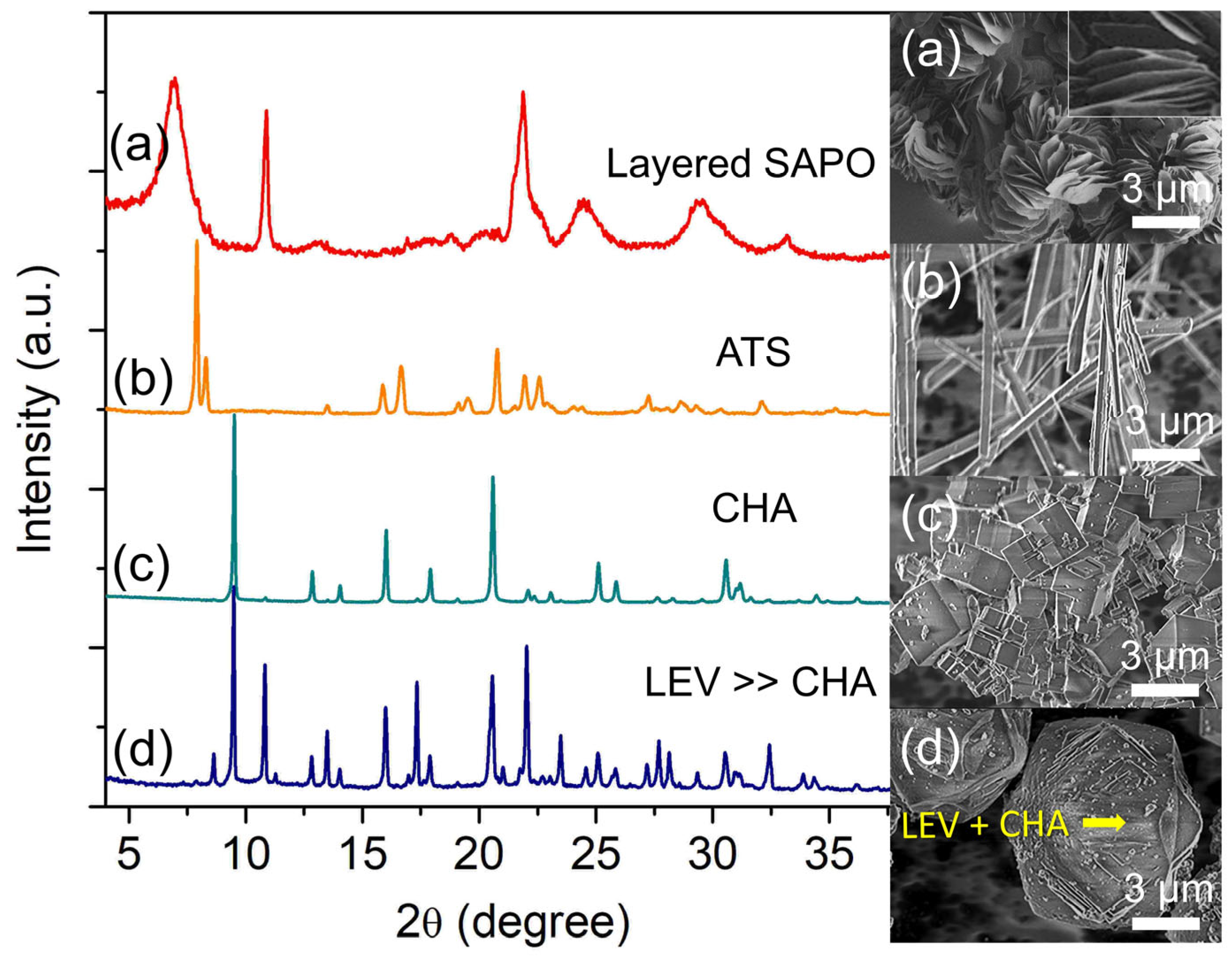
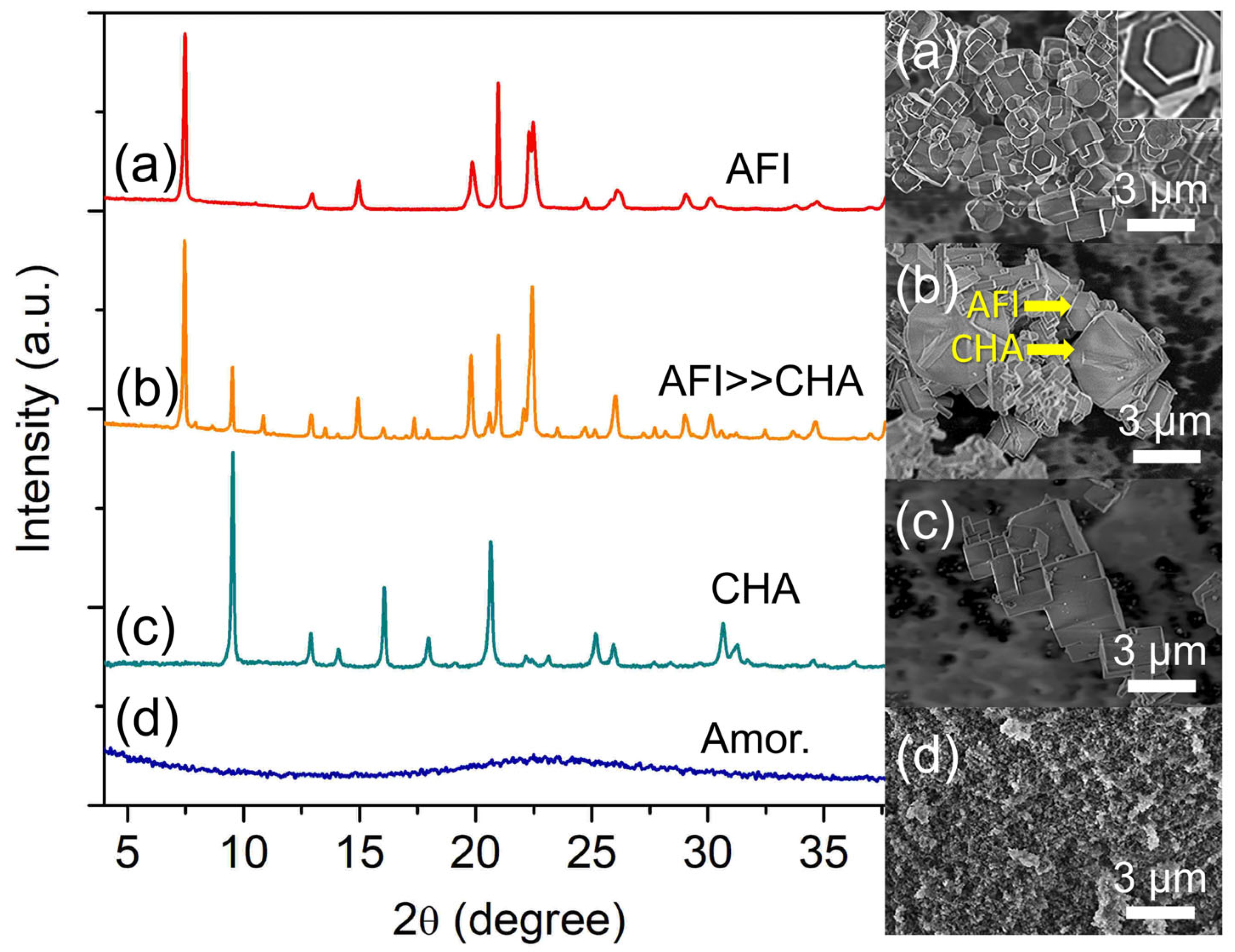

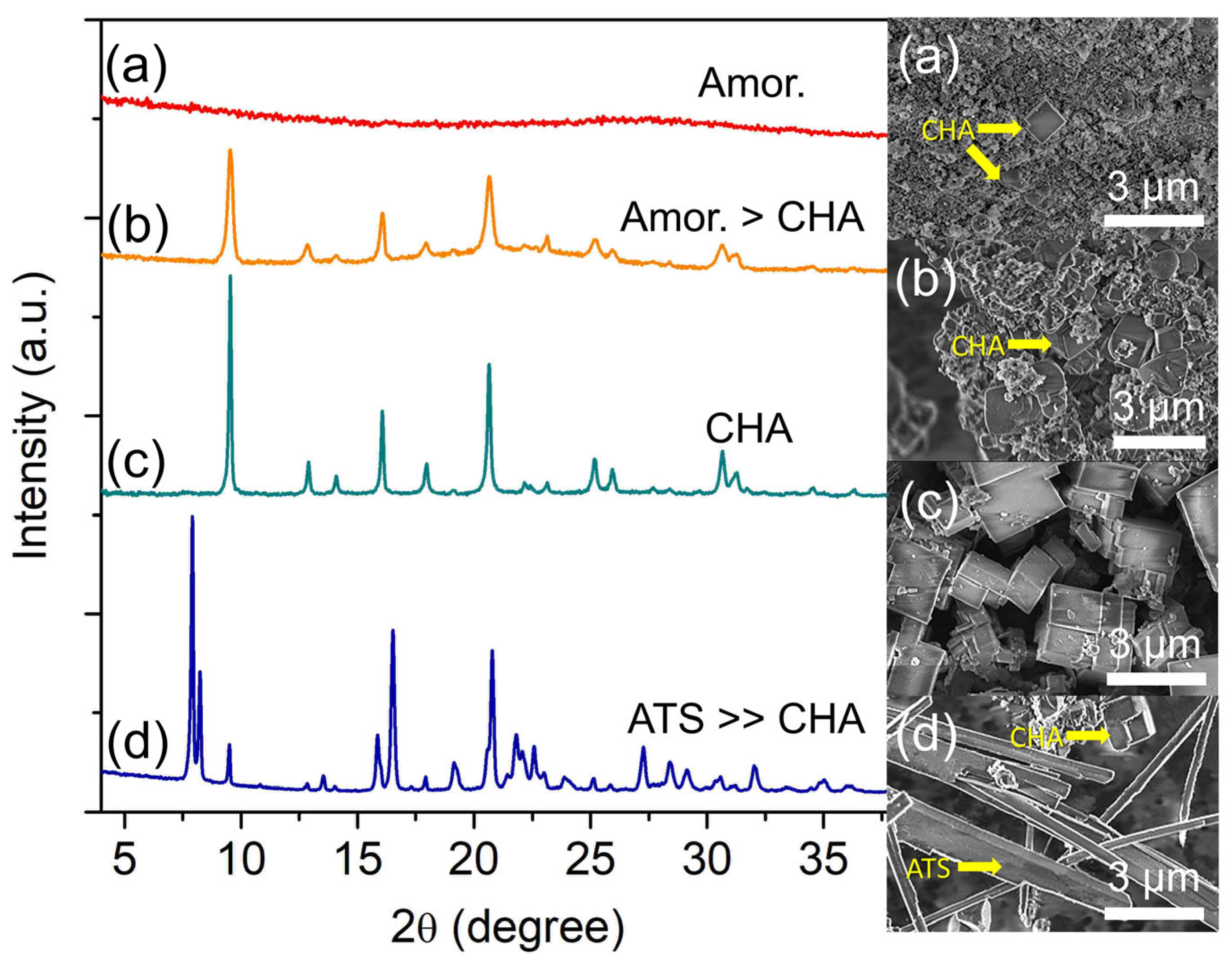
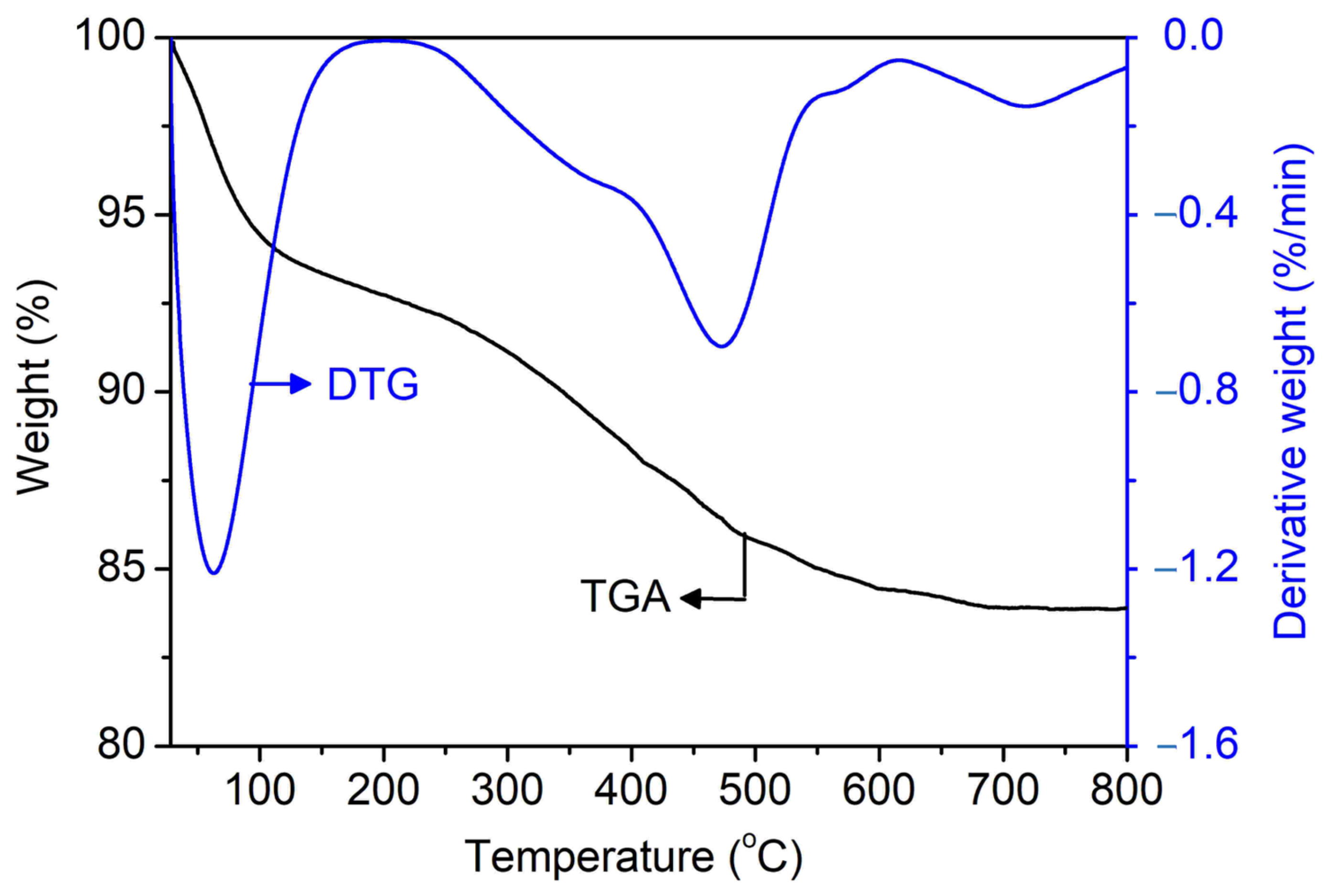

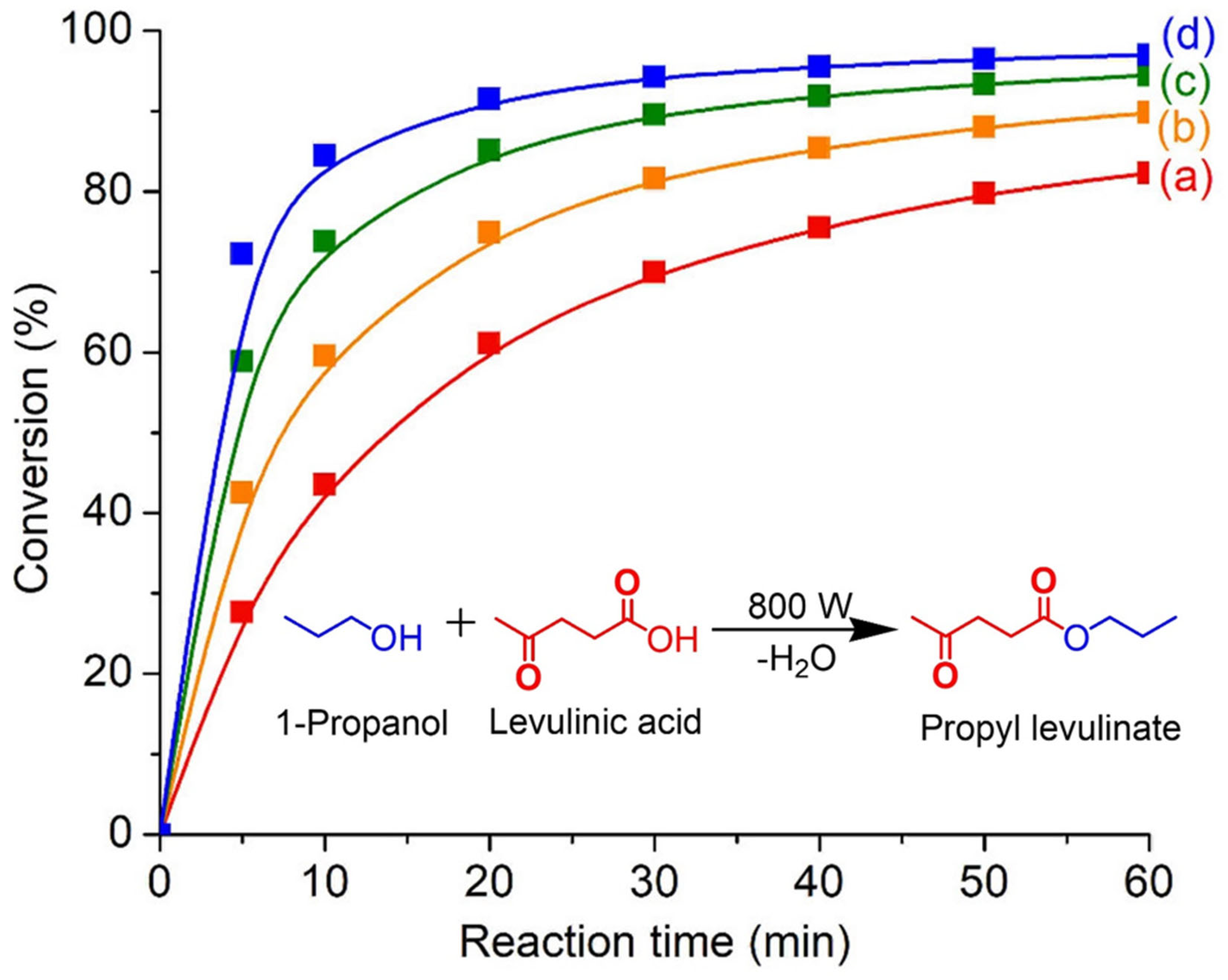
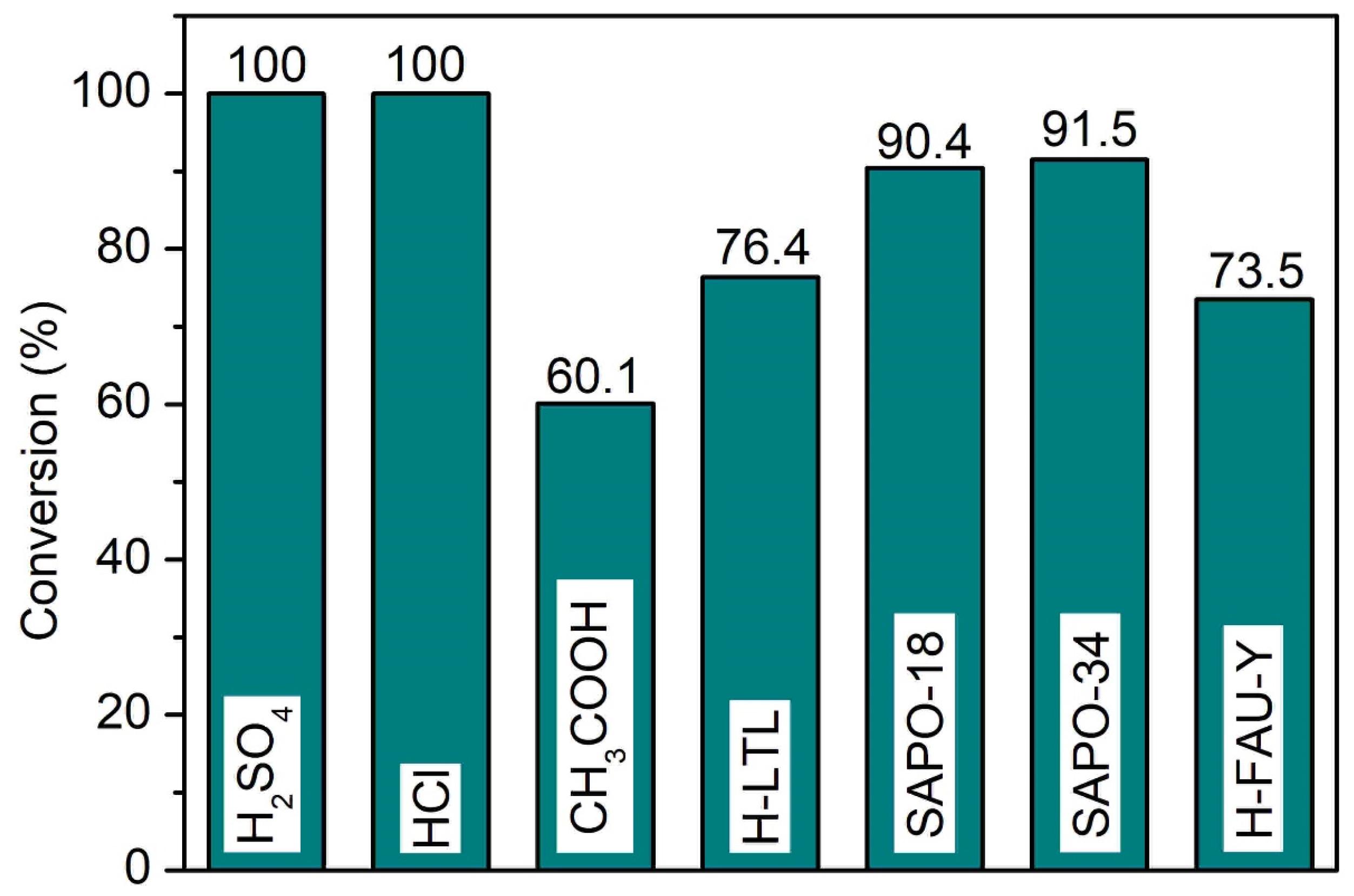
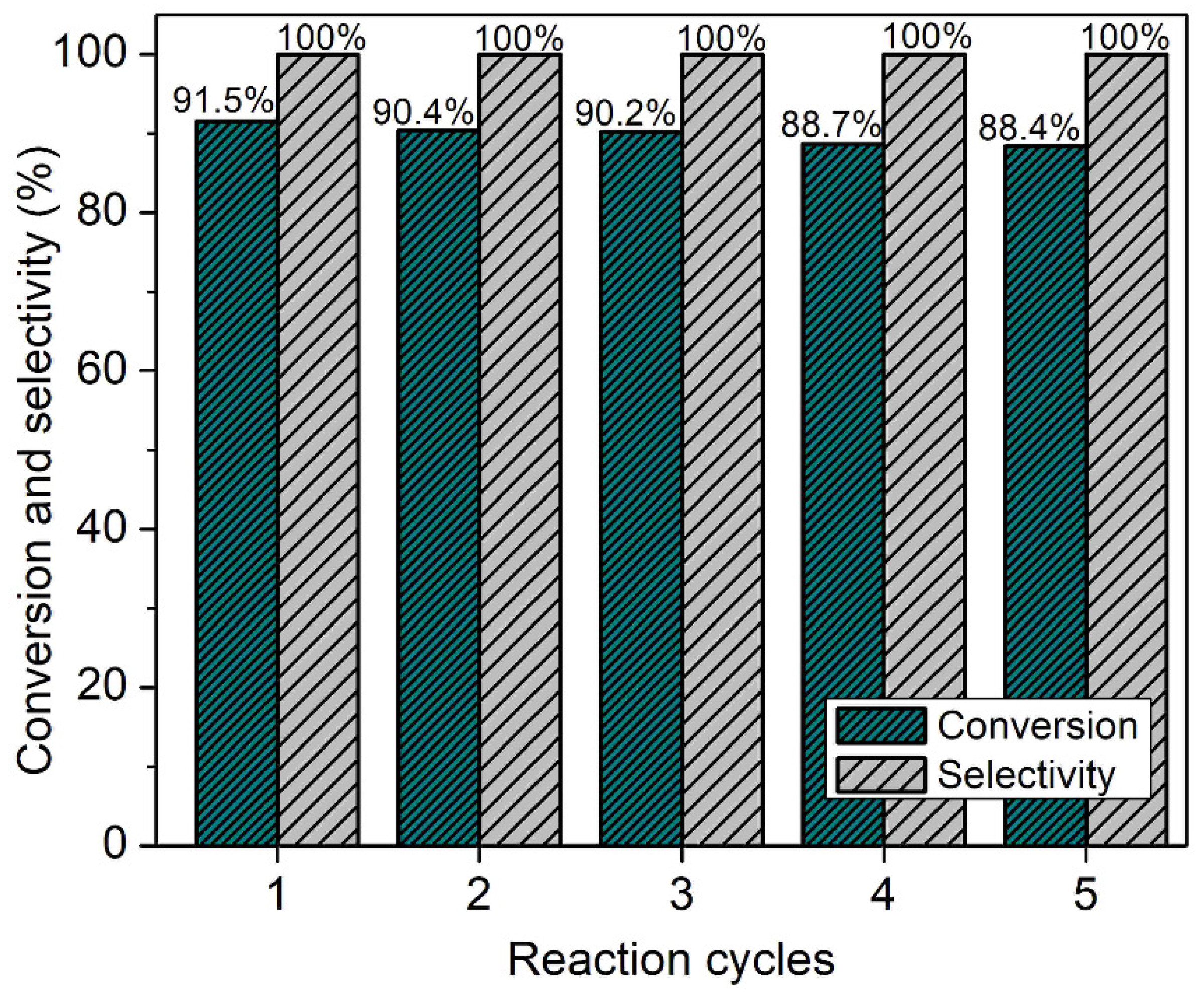
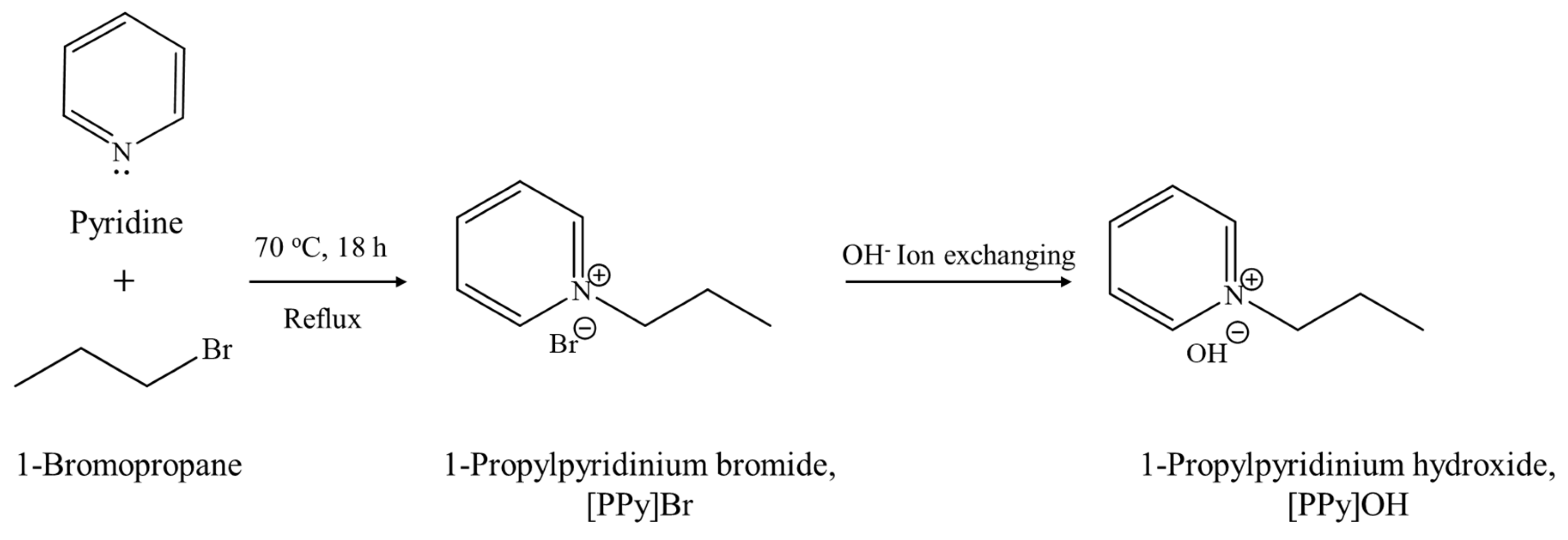
| Sample | Si/(P + Al) Ratio | SBET (m2 g−1) a | SMicro (m2 g−1) b | VTotal (cm3 g−1) c | NH3-TPD (mmol g−1) | ||
|---|---|---|---|---|---|---|---|
| Weak-to-Medium d | Mild-to-Strong e | Total | |||||
| S-3 | 0.24 | 673 | 661 | 0.27 | 1.27 | 1.25 | 2.52 |
| Entry | Variable Parameters | Hydrogel Composition in Molar Ratio | T (°C) | t (h) | pH before Synthesis | pH after Synthesis | Products * | ||||
|---|---|---|---|---|---|---|---|---|---|---|---|
| Al | P | Si | [PPy] | H2O | |||||||
| S-0 | Crystallization time | 2.0 | 4.7 | 0.9 | 6.7 | 148 | 200 | 6 | 6.68 | 6.75 | No solid |
| S-1 | 12 | 6.72 | 6.80 | Am | |||||||
| S-2 | 16 | 6.81 | 6.92 | Am ≫ CHA | |||||||
| S-3 | 19 | 6.67 | 6.88 | CHA | |||||||
| S-4 | 30 | 6.70 | 6.90 | ATS ≫ CHA | |||||||
| S-5 | P2O5 | 2.0 | 4.1 | 0.9 | 6.7 | 148 | 200 | 19 | 7.18 | 7.23 | Am |
| S-3 | 4.7 | 6.67 | 6.88 | CHA | |||||||
| S-6 | 5.3 | 6.18 | 6.77 | CHA > AFI | |||||||
| S-7 | 5.9 | 5.61 | 6.34 | AFI | |||||||
| S-8 | SiO2 | 2.0 | 4.7 | 0 | 6.7 | 148 | 200 | 19 | 6.76 | 7.00 | Layered SAPO |
| S-9 | 0.5 | 7.06 | 7.15 | ATS | |||||||
| S-3 | 0.9 | 6.67 | 6.88 | CHA | |||||||
| S-10 | 1.4 | 6.86 | 7.00 | LEV ≫ CHA | |||||||
| S-11 | [PPy]2O | 2.0 | 4.7 | 0.9 | 5.3 | 148 | 200 | 19 | 5.76 | 6.79 | AFI |
| S-12 | 6.0 | 6.31 | 6.64 | AFI ≫ CHA | |||||||
| S-3 | 6.7 | 6.67 | 6.88 | CHA | |||||||
| S-13 | 7.4 | 7.12 | 7.21 | Am | |||||||
| S-14 | H2O | 2.0 | 4.7 | 0.9 | 6.7 | 116 | 200 | 19 | 7.03 | 7.09 | ATS ≫ CHA |
| S-3 | 148 | 6.67 | 6.88 | CHA | |||||||
| S-15 | 180 | 6.55 | 6.86 | ATS ≫ LEV > CHA | |||||||
| S-16 | 240 | 6.49 | 6.85 | AFI ≫ ATS | |||||||
| S-17 | Heating temperature | 2.0 | 4.7 | 0.9 | 6.7 | 148 | 160 | 19 | 6.79 | 7.09 | Am ≫ CHA |
| S-18 | 180 | 6.73 | 7.09 | Am > CHA | |||||||
| S-3 | 200 | 6.67 | 6.88 | CHA | |||||||
| S-19 | 220 | 6.80 | 6.44 | ATS ≫ CHA | |||||||
Disclaimer/Publisher’s Note: The statements, opinions and data contained in all publications are solely those of the individual author(s) and contributor(s) and not of MDPI and/or the editor(s). MDPI and/or the editor(s) disclaim responsibility for any injury to people or property resulting from any ideas, methods, instructions or products referred to in the content. |
© 2023 by the authors. Licensee MDPI, Basel, Switzerland. This article is an open access article distributed under the terms and conditions of the Creative Commons Attribution (CC BY) license (https://creativecommons.org/licenses/by/4.0/).
Share and Cite
Ma, Y.-K.; Alomar, T.S.; AlMasoud, N.; El-Bahy, Z.M.; Chia, S.; Daou, T.J.; Khoerunnisa, F.; Ling, T.C.; Ng, E.-P. Effects of Synthesis Variables on SAPO-34 Crystallization Templated Using Pyridinium Supramolecule and Its Catalytic Activity in Microwave Esterification Synthesis of Propyl Levulinate. Catalysts 2023, 13, 680. https://doi.org/10.3390/catal13040680
Ma Y-K, Alomar TS, AlMasoud N, El-Bahy ZM, Chia S, Daou TJ, Khoerunnisa F, Ling TC, Ng E-P. Effects of Synthesis Variables on SAPO-34 Crystallization Templated Using Pyridinium Supramolecule and Its Catalytic Activity in Microwave Esterification Synthesis of Propyl Levulinate. Catalysts. 2023; 13(4):680. https://doi.org/10.3390/catal13040680
Chicago/Turabian StyleMa, Yik-Ken, Taghrid S. Alomar, Najla AlMasoud, Zeinhom M. El-Bahy, Stephen Chia, T. Jean Daou, Fitri Khoerunnisa, Tau Chuan Ling, and Eng-Poh Ng. 2023. "Effects of Synthesis Variables on SAPO-34 Crystallization Templated Using Pyridinium Supramolecule and Its Catalytic Activity in Microwave Esterification Synthesis of Propyl Levulinate" Catalysts 13, no. 4: 680. https://doi.org/10.3390/catal13040680
APA StyleMa, Y.-K., Alomar, T. S., AlMasoud, N., El-Bahy, Z. M., Chia, S., Daou, T. J., Khoerunnisa, F., Ling, T. C., & Ng, E.-P. (2023). Effects of Synthesis Variables on SAPO-34 Crystallization Templated Using Pyridinium Supramolecule and Its Catalytic Activity in Microwave Esterification Synthesis of Propyl Levulinate. Catalysts, 13(4), 680. https://doi.org/10.3390/catal13040680









